主流的key-value存储系统,都是在系统内部维护⼀个hash表,因为对hash表的操作时间复杂度为O(1)。如果数据增加以后,导致冲突严重,时间复杂度增加,则可以对hash表进⾏rehash,以此来保证操作的常 量时间复杂度。那么,对于这样⼀个基于hash表的key-value存储系统,是如何提供这么丰富的数据结构的呢?这些数据 结构在内存中如何存储呢?这篇⽂章将⽤⼤量的图⽚演示redis的内存布局和数据存储。
1、Hash算法
先来看⼀个思考题,⽐如我们有⼀个k-v系统,如果我们把k-v系统设计成链表,⽐如 {"baidu":www.baidu.com, "taobao":www.taobao.com, "xinlang":www.sina.com, "lingsheng":www.0voice.com} 那如果我们要去这个链表中查找“lingsheng”的url的话,那么我们就必须遍历整个链表,然后与每⼀个链 表的key去做strcmp才能找到或者找不到这个key,这样的做法是极其低效的,是⼀个O(n)的复杂度,如果 我们有10W个key是不可能使⽤链表去存储的,那怎么办呢?在这⾥我们先来介绍下hash,所谓hash就是给定⼀个字符串或者其它的任意值x,通过hash函数得到⼀个 散列值hash(x),⽐如说我们给定“lingsheng”,使⽤MurmurHash64B得到的hash值就是:7740020151228311510。好了,介绍到这⾥,我们可以尝试来解决这个k-v系统了,在这⾥我们就是使⽤hash表,hash表的意思就 是就是建⽴⼀个数组:
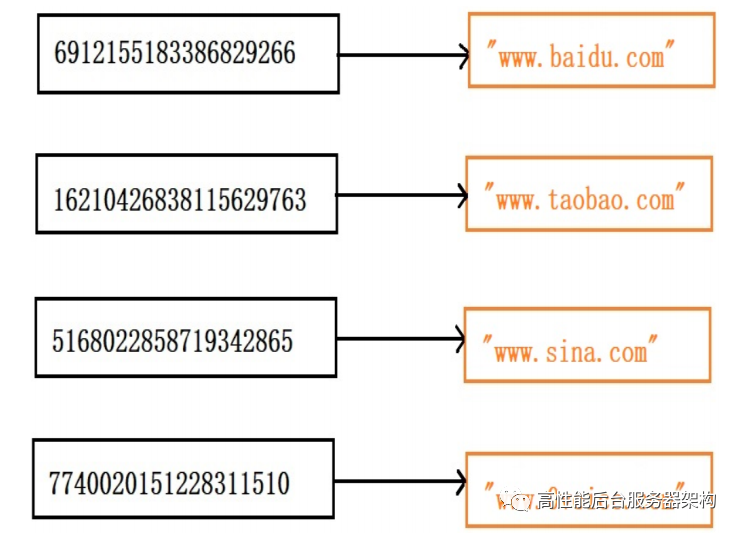
此时引⼊了⼀个⽭盾:1、如果通过索引(hash值)去读取hash表,这样设计的hash表会⾮常⼤,占⽤的内存是⾮常庞⼤的;2、如果是通过hash值遍历hash表,如果k-v数量很多,则查找性能会是O(N),则时间性能也很低。那redis是如何解决这个⽭盾的?另外,hash会有碰撞,即使再好的算法只是碰撞率低⽽已,那么redis是 如何解决碰撞的?
2、redis的字典
2.1 、redis的hash表
在介绍hash字典的时候,先来看看redis的hash表:
/* This is our hash table structure. Every dictionary has two of this as we2 * implement incremental rehashing, for the old to the new table.*/typedef struct dictht {dictEntry **table;unsigned long size;unsigned long sizemask;unsigned long used;} dictht;
table 属性是⼀个数组, 数组中的每个元素都是⼀个指向 dict.h/dictEntry 结构的指针, 每个 dictEntry 结构保存着⼀个键值对;size 属性记录了哈希表的⼤⼩, 也即是 table 数组的⼤⼩, ⽽ used 属性则记录了哈希表⽬前已有节 点(键值对)的数量;sizemask 属性的值总是等于 size - 1 , 这个属性和哈希值⼀起决定⼀个键应该被放到 table 数组的 哪个索引上⾯;used属性,表示hash表⾥已有的数量。如下图展示了⼀个空的hash表:
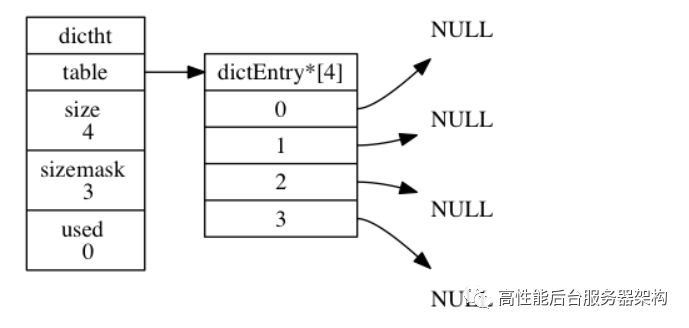
2.2 、hash表的节点
哈希表节点使⽤ dictEntry 结构表示, 每个 dictEntry 结构都保存着⼀个键值对:
typedef struct dictEntry {// 键void *key;// 值union {void *val;uint64_t u64;int64_t s64;double d;} v;// 指向下个哈希表节点,形成链表struct dictEntry *next;} dictEntry;
key 属性保存着键值对中的键, ⽽ v 属性则保存着键值对中的值, 其中键值对的值可以是⼀个指针, 或 者是⼀个 uint64_t 整数, ⼜或者是⼀个 int64_t 整数,或者是double类型。next 属性是指向另⼀个哈希表节点的指针, 这个指针可以将多个哈希值相同的键值对连接在⼀次, 以此 来解决键冲突(collision)的问题。举个例⼦, 下图图就展示了如何通过 next 指针, 将两个索引值相同的键 k1 和 k0 连接在⼀起。
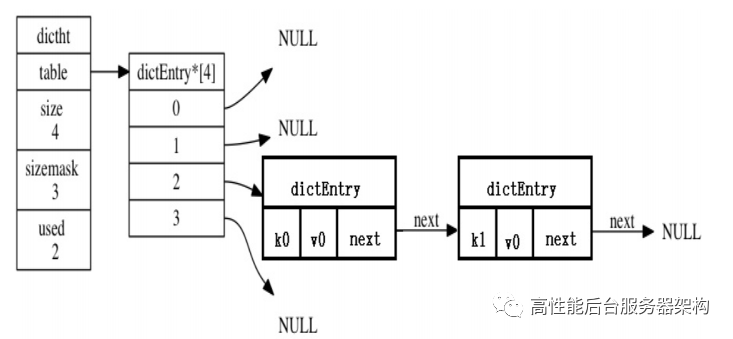
2.3 、redis字典
先来看字典的定义:
typedef struct dict {// 字典类型dictType *type;// 字典的私有数据void *privdata;// 哈希表,⼆维的,默认使⽤ht[0],当需要进⾏rehash的时候,会利⽤ht[1]进⾏dictht ht[2];// rehash的索引,当没有进⾏rehash时其值为-1long rehashidx; /* rehashing not in progress if rehashidx ==-1 */// hash表的迭代器,⼀般⽤于rehash和主从复制等等unsigned long iterators; /* number of iterators currently running */} dict;
type 属性和 privdata 属性是针对不同类型的键值对, 为创建多态字典⽽设置的:
-
type 属性是⼀个指向 dictType 结构的指针, 每个 dictType 结构保存了⼀簇⽤于操作特定类型键值 对的函数, Redis 会为⽤途不同的字典设置不同的类型特定函数。
-
⽽ privdata 属性则保存了需要传给那些类型特定函数的可选参数
typedef struct dictType {uint64_t (*hashFunction)(const void *key);void *(*keyDup)(void *privdata, const void *key);void *(*valDup)(void *privdata, const void *obj);int (*keyCompare)(void *privdata, const void *key1, const void*key2);void (*keyDestructor)(void *privdata, void *key);void (*valDestructor)(void *privdata, void *obj);} dictType;
ht 属性是⼀个包含两个项的数组, 数组中的每个项都是⼀个 dictht 哈希表, ⼀般情况下, 字典只使⽤ ht[0] 哈希表, ht[1] 哈希表只会在对 ht[0] 哈希表进⾏ rehash 时使⽤。除了 ht[1] 之外, 另⼀个和 rehash 有关的属性就是 rehashidx :它记录了 rehash ⽬前的进度, 如果 ⽬前没有在进⾏ rehash , 那么它的值为 -1 。如下图展示了⼀个普通的字典:

那么现在,我们先来回答下上⾯的第⼀个问题:
redis是如何解决时间效率和空间效率的?先来回答下:1、初始时,字典的hash表的⼤⼩只有4(sizemask为3),那么通过hash函数计算出的 hash值可能会很⼤,此时hash值会与上(&)sizemask,得到存储在hash表⾥的table[index],序号的, ⻅如下代码:
# 使⽤字典设置的哈希函数,计算键 key 的哈希值hash = dict->type->hashFunction(key);# 使⽤哈希表的 sizemask 属性和哈希值,计算出索引值# 根据情况不同, ht[x] 可以是 ht[0] 或者 ht[1]index = hash & dict->ht[x].sizemask;
⽐如我们dictFind的实现,通过key获取hash表的节点(即通过key获取value)
dictEntry *dictAddRaw(dict *d, void *key, dictEntry **existing)2 {long index;dictEntry *entry;dictht *ht;if (dictIsRehashing(d)) _dictRehashStep(d);/* Get the index of the new element, or -1 if* the element already exists. */if ((index = _dictKeyIndex(d, key, dictHashKey(d,key), existing)) == -1)return NULL;/* Allocate the memory and store the new entry.* Insert the element in top, with the assumption that in a database* system it is more likely that recently added entries are accessed* more frequently. */ht = dictIsRehashing(d) ? &d->ht[1] : &d->ht[0];entry = zmalloc(sizeof(*entry));entry->next = ht->table[index];ht->table[index] = entry;ht->used++;/* Set the hash entry fields. */dictSetKey(d, entry, key);return entry;}static long _dictKeyIndex(dict *d, const void *key, uint64_t hash, dictEntry **existing){unsigned long idx, table;dictEntry *he;if (existing) *existing = NULL;/* Expand the hash table if needed */if (_dictExpandIfNeeded(d) == DICT_ERR)return -1;for (table = 0; table <= 1; table++) {idx = hash & d->ht[table].sizemask;/* Search if this slot does not already contain the givenkey */he = d->ht[table].table[idx];举个例⼦,我们上⽂说到了4个url,那是如何存储到⼀个空的hash表⾥的呢?插⼊到字典后,字典结构如下:while(he) {if (key==he->key || dictCompareKeys(d, key, he->key)){if (existing) *existing = he;return -1;}he = he->next;}if (!dictIsRehashing(d)) break;}return idx;}
举个例⼦,我们上⽂说到了4个url,那是如何存储到⼀个空的hash表⾥的呢?
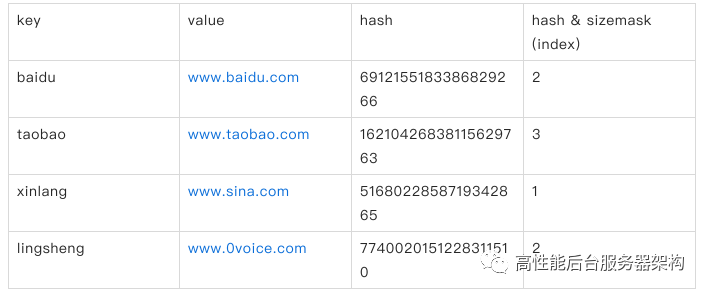
插⼊到字典后,字典结构如下:
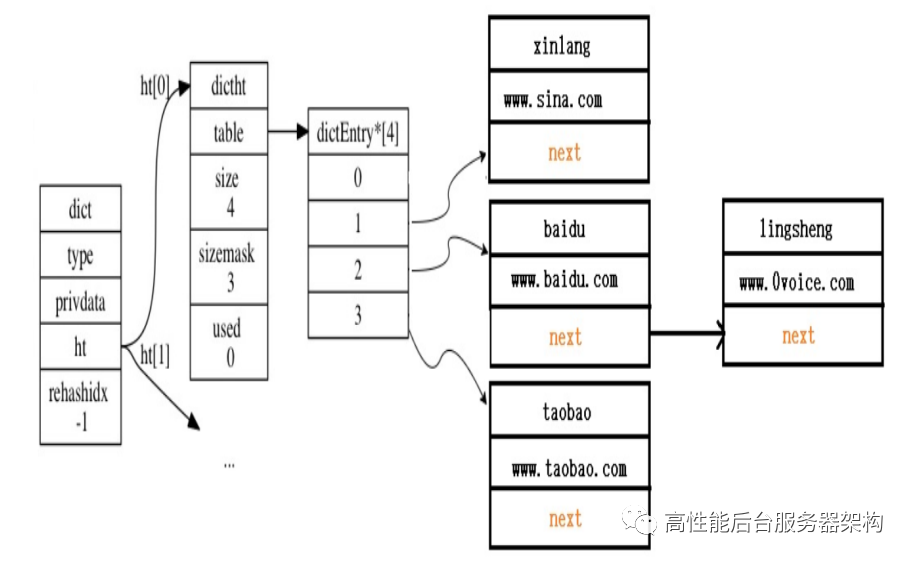
总结下:hash表是随着K-V数量的增⼤⽽逐步增⼤的,并不直接以key的hash值为下标去取值得,⽽是以 hash & sizemask去获取hash表的对应节点的;hash表的节点实际上是⼀个链表,如果hash & sizemask有冲突,则也把冲突key放在hash表的链表上,取值得时候还得遍历hash表⾥的链表。
3、redis的数据库的结构
在redis的内部,有⼀个redisServer结构体的全局变量server,server保存了redis服务端所有的信息,包 括当前进程的PID、服务器的端⼝号、数据库个数、统计信息等等。当然,它也包含了数据库信息,包括数 据库的个数、以及⼀个redisDb数组。
struct redisServer {...redisDb *db;int dbnum; /* Total number of configured DBs */...
显然,dbnum就是redisDb数组的⻓度,每⼀个数据库,都对应于⼀个redisDb,在redis的客户端中,可 以通过select N来选择使⽤哪⼀个数据库,各个数据库之间互相独⽴。例如:可以在不同的数据库中同时 存在名为”0voice”的key。从上⾯的分析中可以看到,server是⼀个全局变量,它包含了若⼲个redisDb,每⼀个redisDb是⼀个 keyspace,各个keyspace互相独⽴,互不⼲扰。
下⾯来看⼀下redisDb的定义:
/* Redis database representation. There are multiple databases identified* by integers from 0 (the default database) up to the max configured* database. The database number is the 'id' field in the structure. */typedef struct redisDb {dict *dict; /* The keyspace for this DB */dict *expires; /* Timeout of keys with a timeoutset */dict *blocking_keys; /* Keys with clients waiting fordata (BLPOP)*/dict *ready_keys; /* Blocked keys that received a PUSH */dict *watched_keys; /* WATCHED keys for MULTI/EXEC CAS */int id; /* Database ID */long long avg_ttl; /* Average TTL, just for stats */list *defrag_later; /* List of key names to attempt to defrag one by one, gradually. */} redisDb;
redis的每⼀个数据库是⼀个独⽴的keyspace,因此,我们理所当然的认为,redis的数据库是⼀个hash 表。但是,从redisDb的定义来看,它并不是⼀个hash表,⽽是⼀个包含了很多hash表的结构。之所以这 样做,是因为redis还需要提供除了set、get以外更加丰富的功能(例如:键的超时机制)。
4、rehash
随着操作的不断执⾏, 哈希表保存的键值对会逐渐地增多或者减少, 为了让哈希表的负载因⼦(ratio) 维持在⼀个合理的范围之内, 当哈希表保存的键值对数量太多或者太少时, 程序需要对哈希表的⼤⼩进⾏ 相应的扩展或者收缩。⽐如,hash表的size为4,如果已经插⼊了4个k-v的话,则ratio 为 1 扩展和收缩哈希表的⼯作可以通过执⾏ rehash (重新散列)操作来完成, Redis 对字典的哈希表执⾏ rehash 的策略如下:
-
1、 如果ratio⼩于0.1,则会对hash表进⾏收缩操作
/* If the percentage of used slots in the HT reaches HASHTABLE_MIN_FILL* we resize the hash table to save memory */void tryResizeHashTables(int dbid) {if (htNeedsResize(server.db[dbid].dict))dictResize(server.db[dbid].dict);if (htNeedsResize(server.db[dbid].expires))dictResize(server.db[dbid].expires);}int htNeedsResize(dict *dict) {long long size, used;size = dictSlots(dict);used = dictSize(dict);return (size > DICT_HT_INITIAL_SIZE &&(used*100/size < HASHTABLE_MIN_FILL));}
-
2、服务器⽬前没有在执⾏ BGSAVE 命令或者 BGREWRITEAOF 命令, 并且哈希表的负载因⼦⼤于 等于 1 ,则扩容hash表,扩容⼤⼩为当前ht[0].used*2
-
3、服务器⽬前正在执⾏ BGSAVE 命令或者 BGREWRITEAOF 命令, 并且哈希表的负载因⼦⼤于等 于 5,则扩容hash表,并且扩容⼤⼩为当前ht[0].used*2
/* Expand the hash table if needed */static int _dictExpandIfNeeded(dict *d){/* Incremental rehashing already in progress. Return. */if (dictIsRehashing(d)) return DICT_OK;/* If the hash table is empty expand it to the initial size.*/if (d->ht[0].size == 0) return dictExpand(d, DICT_HT_INITIAL_SIZE);/* If we reached the 1:1 ratio, and we are allowed to resizethe hash* table (global setting) or we should avoid it but the ratiobetween* elements/buckets is over the "safe" threshold, we resize doubling* the number of buckets. */if (d->ht[0].used >= d->ht[0].size &&(dict_can_resize ||d->ht[0].used/d->ht[0].size > dict_force_resize_ratio)){return dictExpand(d, d->ht[0].used*2);}return DICT_OK;}
其实上⽂说的扩容为ht[0].uesd*2 是不严谨的,实际上是⼀个刚好⼤于该书的2的N次⽅.
unsigned long realsize = _dictNextPower(size);/* Our hash table capability is a power of two */static unsigned long _dictNextPower(unsigned long size){unsigned long i = DICT_HT_INITIAL_SIZE;if (size >= LONG_MAX) return LONG_MAX + 1LU;while(1) {if (i >= size)return i;i *= 2;}}
扩容的步骤如下:1、为字典ht[1]哈希表分配合适的空间;2、将ht[0]中所有的键值对rehash到ht[1]:rehash 指的是重新计算键的哈希值和索引值, 然后将键值对 放置到 ht[1] 哈希表的指定位置上;3、当 ht[0] 包含的所有键值对都迁移到了 ht[1] 之后 (ht[0] 变为空表), 释放 ht[0] , 将 ht[1] 设置 为 ht[0] , 并在 ht[1] 新创建⼀个空⽩哈希表, 为下⼀次 rehash 做准备。
文末给大家分享一些c/c++ Linux服务器高阶知识视频资料,需要的朋友
加入到群里一起探讨技术交流

知识点有C/C++,Linux,golang技术,Nginx,ZeroMQ,MySQL,Redis,fastdfs,MongoDB,ZK,流媒体,CDN,P2P,K8S,Docker,TCP/IP,协程,DPDK等等。

4、渐进式rehash
上⼀节说过, 扩展或收缩哈希表需要将 ht[0] ⾥⾯的所有键值对 rehash 到 ht[1] ⾥⾯, 但是, 这个 rehash 动作并不是⼀次性、集中式地完成的, ⽽是分多次、渐进式地完成的。这样做的原因在于, 如果 ht[0] ⾥只保存着四个键值对, 那么服务器可以在瞬间就将这些键值对全部 rehash 到 ht[1] ;但是, 如果哈希表⾥保存的键值对数量不是四个, ⽽是四百万、四千万甚⾄四亿个键 值对, 那么要⼀次性将这些键值对全部 rehash 到 ht[1] 的话, 庞⼤的计算量可能会导致服务器在⼀段时 间内停⽌服务。因此, 为了避免 rehash 对服务器性能造成影响, 服务器不是⼀次性将 ht[0] ⾥⾯的所有键值对全部 rehash 到 ht[1] , ⽽是分多次、渐进式地将 ht[0] ⾥⾯的键值对慢慢地 rehash 到 ht[1] 。以下是哈希表渐进式 rehash 的详细步骤:1. 为 ht[1] 分配空间, 让字典同时持有 ht[0] 和 ht[1] 两个哈希表。2. 在字典中维持⼀个索引计数器变量 rehashidx , 并将它的值设置为 0 , 表示 rehash ⼯作正式开 始。
3. 在 rehash 进⾏期间, 每次对字典执⾏添加、删除、查找或者更新操作时, 程序除了执⾏指定的操作 以外, 还会顺带将 ht[0] 哈希表在 rehashidx 索引上的所有键值对 rehash 到 ht[1] , 当 rehash ⼯ 作完成之后, 程序将 rehashidx 属性的值增⼀。4. 随着字典操作的不断执⾏, 最终在某个时间点上, ht[0] 的所有键值对都会被 rehash ⾄ ht[1] , 这 时程序将 rehashidx 属性的值设为 -1 , 表示 rehash 操作已完成。渐进式 rehash 的好处在于它采取分⽽治之的⽅式, 将 rehash 键值对所需的计算⼯作均滩到对字典的每 个添加、删除、查找和更新操作上,甚⾄是后台启动⼀个定时器,每次时间循环时只⼯作⼀毫秒, 从⽽避 免了集中式 rehash ⽽带来的庞⼤计算量。
/* This function handles 'background' operations we are requiredto do2 * incrementally in Redis databases, such as active key expiring,resizing,3 * rehashing. */void databasesCron(void) {.../* Perform hash tables rehashing if needed, but only if thereare no* other processes saving the DB on disk. Otherwise rehashingis bad* as will cause a lot of copy-on-write of memory pages. */if (server.rdb_child_pid == -1 && server.aof_child_pid == -1){/* Resize */for (j = 0; j < dbs_per_call; j++) {tryResizeHashTables(resize_db % server.dbnum);resize_db++;}/* Rehash */if (server.activerehashing) {for (j = 0; j < dbs_per_call; j++) {int work_done = incrementallyRehash(rehash_db);if (work_done) {/* If the function did some work, stop here,we'll do* more at the next cron loop. */break;} else {/* If this db didn't need rehash, we'll try the next one. */rehash_db++;rehash_db %= server.dbnum;}}}}}/* Our hash table implementation performs rehashing incrementallywhile* we write/read from the hash table. Still if the server is idle, the hash* table will use two tables for a long time. So we try to use 1millisecond* of CPU time at every call of this function to perform some rehahsing.** The function returns 1 if some rehashing was performed, otherwise 0* is returned. */int incrementallyRehash(int dbid) {/* Keys dictionary */if (dictIsRehashing(server.db[dbid].dict)) {dictRehashMilliseconds(server.db[dbid].dict,1);return 1; /* already used our millisecond for this loop... */}/* Expires */if (dictIsRehashing(server.db[dbid].expires)) {dictRehashMilliseconds(server.db[dbid].expires,1);return 1; /* already used our millisecond for this loop... */}return 0;
5、redisObject
上⽂讲了那么多,可是我们从来没有讲过redis⾥的对象,那么hash表⾥的⼀个个对象都是什么呢?
typedef struct redisObject {unsigned type:4;unsigned encoding:4;unsigned lru:LRU_BITS; /* LRU time (relative to global lru_clock) or* LFU data (least significant 8 bits frequency* and most significant 16 bits accesstime). */int refcount;void *ptr;} robj;
redis⾥的对象有11种,之多,他们全都继承于redisObject。
/* Objects encoding. Some kind of objects like Strings and Hashescan be2 * internally represented in multiple ways. The 'encoding' fieldof the object3 * is set to one of this fields for this object. */#define OBJ_ENCODING_RAW 0 /* Raw representation */#define OBJ_ENCODING_INT 1 /* Encoded as integer */#define OBJ_ENCODING_HT 2 /* Encoded as hash table */#define OBJ_ENCODING_ZIPMAP 3 /* Encoded as zipmap */#define OBJ_ENCODING_LINKEDLIST 4 /* No longer used: old list encoding. */#define OBJ_ENCODING_ZIPLIST 5 /* Encoded as ziplist */#define OBJ_ENCODING_INTSET 6 /* Encoded as intset */#define OBJ_ENCODING_SKIPLIST 7 /* Encoded as skiplist */#define OBJ_ENCODING_EMBSTR 8 /* Embedded sds string encoding */#define OBJ_ENCODING_QUICKLIST 9 /* Encoded as linked list of ziplists */#define OBJ_ENCODING_STREAM 10 /* Encoded as a radix tree of listpacks */






















 6247
6247











 被折叠的 条评论
为什么被折叠?
被折叠的 条评论
为什么被折叠?








